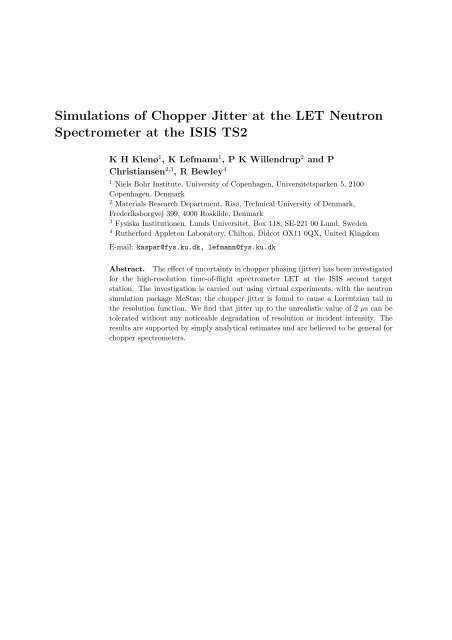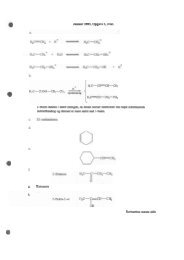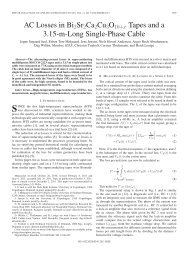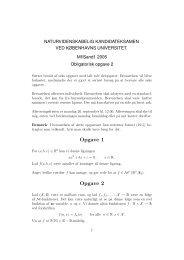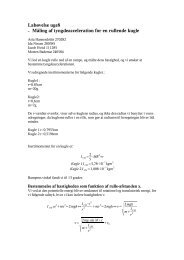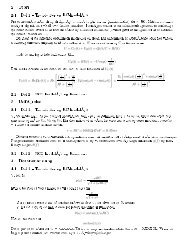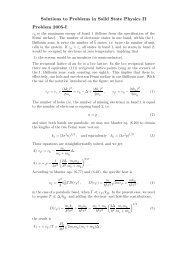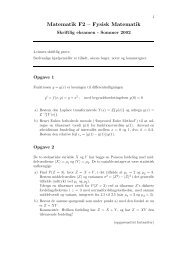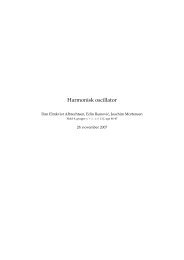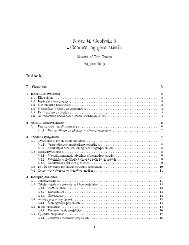Simulations of Chopper Jitter at the LET Neutron Spectrometer at the ...
Simulations of Chopper Jitter at the LET Neutron Spectrometer at the ...
Simulations of Chopper Jitter at the LET Neutron Spectrometer at the ...
You also want an ePaper? Increase the reach of your titles
YUMPU automatically turns print PDFs into web optimized ePapers that Google loves.
<strong>Simul<strong>at</strong>ions</strong> <strong>of</strong> <strong>Chopper</strong> <strong>Jitter</strong> <strong>at</strong> <strong>the</strong> <strong>LET</strong> <strong>Neutron</strong> <strong>Spectrometer</strong> <strong>at</strong> <strong>the</strong> ISIS TS2 3Figure 2. <strong>LET</strong> chopper and guide layout. Top panel shows <strong>the</strong> chopper distancesand chopper geometry. Bottom panel shows <strong>the</strong> layout <strong>of</strong> <strong>the</strong> guide, with <strong>the</strong> chopperpositions outlined.[7]• The slow Frame Overlap (FO) chopper removes long wavelength neutrons from <strong>the</strong>previous moder<strong>at</strong>or pulse.• The Pulse Removal (PR) chopper selectively removes pulses, to increase pulsesepar<strong>at</strong>ion, by running <strong>at</strong> an integer factor slower than <strong>the</strong> resolution choppers.This is illustr<strong>at</strong>ed in fig. 4, where <strong>the</strong> PR is run <strong>at</strong> half <strong>the</strong> speed <strong>of</strong> <strong>the</strong> resolutionchoppers, to remove every second pulse.• The contaminant removal chopper (CR) removes fast neutrons coming from <strong>the</strong> tail<strong>of</strong> <strong>the</strong> pulse.[4]Illustr<strong>at</strong>ed by simul<strong>at</strong>ion results in figure 4, <strong>the</strong> white beam from <strong>the</strong> short pulsed(4 µs) moder<strong>at</strong>or is separ<strong>at</strong>ed into a few distinct wavelengths by <strong>the</strong> first set <strong>of</strong> fast
<strong>Simul<strong>at</strong>ions</strong> <strong>of</strong> <strong>Chopper</strong> <strong>Jitter</strong> <strong>at</strong> <strong>the</strong> <strong>LET</strong> <strong>Neutron</strong> <strong>Spectrometer</strong> <strong>at</strong> <strong>the</strong> ISIS TS2 4Figure 3. A picture <strong>of</strong> <strong>the</strong> actual Res 2 chopper, where <strong>the</strong> double slits are clearlyvisible.SampleRes2CRPRRes1 & FOGuide startFigure 4. Flight distance vs time in ray tracing, showing <strong>the</strong> ”white” beam from<strong>the</strong> moder<strong>at</strong>or in <strong>the</strong> energy range 4.9-5.1 meV, being separ<strong>at</strong>ed into a few distinctwavelengths by <strong>the</strong> first resolution choppers (Res1) <strong>at</strong> 7.83 m, with <strong>the</strong> desiredwavelength singled out by <strong>the</strong> pulse removal (PR) chopper <strong>at</strong> 11.75 mresolution choppers (Res1). The desired wavelength is singled out by <strong>the</strong> slow pulseremoval (PR) chopper, as can be seen in <strong>the</strong> energy distribution in fig. 5.Note also <strong>the</strong> novel double funnel system <strong>at</strong> <strong>the</strong> Res2 choppers, seen in fig. 2,designed to fur<strong>the</strong>r increase <strong>the</strong> resolution <strong>of</strong> <strong>the</strong> instrument, by allowing more narrowchopper windows, without sacrificing neutron flux.[5]
<strong>Simul<strong>at</strong>ions</strong> <strong>of</strong> <strong>Chopper</strong> <strong>Jitter</strong> <strong>at</strong> <strong>the</strong> <strong>LET</strong> <strong>Neutron</strong> <strong>Spectrometer</strong> <strong>at</strong> <strong>the</strong> ISIS TS2 53. <strong>Chopper</strong> <strong>Jitter</strong>Physical beam choppers are never perfectly <strong>at</strong> <strong>the</strong> desired phase, but r<strong>at</strong>her devi<strong>at</strong>e bya random error <strong>at</strong> any given time. Whereas most neutron simul<strong>at</strong>ions are performedwith m<strong>at</strong>hem<strong>at</strong>ically perfect beam choppers, here a random phase error (jitter) is addedto give more physically realistic choppers. For <strong>the</strong> purposes <strong>of</strong> this article we choose <strong>the</strong>jitter to be Gaussian, parametrized by <strong>the</strong> width <strong>of</strong> <strong>the</strong> Gaussian error[6]The size <strong>of</strong> <strong>the</strong> jitter is <strong>the</strong>n defined as <strong>the</strong> width <strong>of</strong> <strong>the</strong> Gaussian error, which is usedas <strong>the</strong> jitter parameter.For every event where a neutron ray reaches a chopper, <strong>the</strong> phase θ is calcul<strong>at</strong>ed thus:θ = θ 0 + j ∗ rand norm ∗ ω (1)Where θ 0 is <strong>the</strong> chopper position without jitter, j is <strong>the</strong> jitter parameter for <strong>the</strong> chopperwith units <strong>of</strong> time, rand norm is a normalized Gaussian random number (with σ 2 = 1)and ω is <strong>the</strong> angular velocity <strong>of</strong> <strong>the</strong> chopper.To illustr<strong>at</strong>e <strong>the</strong> effect <strong>of</strong> chopper jitter, we consider <strong>the</strong> basic equ<strong>at</strong>ion for flight time:t = α ∗ λ ∗ L (2)where λ is <strong>the</strong> neutron wavelength, L is <strong>the</strong> flight length, and <strong>the</strong> constant α isα = m n /h ≈ 252 µs/m/Å.[10]Hence, if <strong>the</strong> jitter is <strong>the</strong> only source <strong>of</strong> uncertainty, we have th<strong>at</strong> <strong>the</strong> uncertainty in <strong>the</strong>wavelength is:dλ = dt(3)αLSo for a realistic jitter value, (dt), <strong>of</strong> 0.4 µs in <strong>the</strong> second resolution choppers, loc<strong>at</strong>ed <strong>at</strong>15.7 m from Res1, this contribute to <strong>the</strong> uncertainty in <strong>the</strong> wavelength (dλ) <strong>of</strong> 6*10 −5 Å,and thus a dE <strong>of</strong> 0.1 µeV for 5 meV neutrons. In comparison <strong>the</strong> resolution is <strong>at</strong> about20 µeV <strong>at</strong> 250 Hz.Since <strong>the</strong> energy <strong>of</strong> neutrons arriving in <strong>the</strong> physical detector bank is calcul<strong>at</strong>ed by<strong>the</strong> ToF-method, a small discrepancy in <strong>the</strong> arrival time <strong>at</strong> <strong>the</strong> sample, can, over <strong>the</strong> 3.5m from <strong>the</strong> sample to detector, transl<strong>at</strong>e into a much larger difference in <strong>the</strong> neutronenergy perceived by <strong>the</strong> detector. Considering again <strong>the</strong> jitter dt = 0.4 µs in <strong>the</strong> 2ndresolution choppers, this corresponds to an uncertainty in <strong>the</strong> perceived wavelength (dλ)<strong>of</strong> 510 −4 Å, and thus a dE <strong>of</strong> 1 µeV for 5 meV neutrons.Some neutron instruments compens<strong>at</strong>es for jitter with a ’veto’ system, where anevent is discarded if an unacceptable discrepancy <strong>of</strong> <strong>the</strong> chopper phase is detected. Theveto scheme is not included in <strong>the</strong> present simul<strong>at</strong>ions.4. Simul<strong>at</strong>ion resultsThe instrument was built in <strong>the</strong> McStas neutron simul<strong>at</strong>ion package[2, 3], by adding<strong>the</strong> physical components (moder<strong>at</strong>or, guide sections, beam choppers) sequentially, with
<strong>Simul<strong>at</strong>ions</strong> <strong>of</strong> <strong>Chopper</strong> <strong>Jitter</strong> <strong>at</strong> <strong>the</strong> <strong>LET</strong> <strong>Neutron</strong> <strong>Spectrometer</strong> <strong>at</strong> <strong>the</strong> ISIS TS2 6monitors interspersed <strong>at</strong> suitable loc<strong>at</strong>ions. Note th<strong>at</strong> <strong>the</strong> monitors used in <strong>the</strong> simul<strong>at</strong>ionsdoes not emul<strong>at</strong>e physical detectors, in as much as <strong>the</strong>y do not alter or absorb <strong>the</strong>detected neutron rays.The simul<strong>at</strong>ions used to gener<strong>at</strong>e <strong>the</strong> figures in this paper were typically run with 5∗10 8rays, which corresponds to approxim<strong>at</strong>ely 20 min. CPU-time on an ordinary dual-corelaptop.Fig. 5 shows <strong>the</strong> energy distribution <strong>of</strong> <strong>the</strong> beam <strong>at</strong> various positions in <strong>the</strong> instrument,with perfect beam choppers. Notice <strong>the</strong> multiple peaks after <strong>the</strong> first resolution choppers,reduced to <strong>the</strong> single 5 meV peak by <strong>the</strong> PR chopper, as would be expected in <strong>the</strong>physical instrument.To illustr<strong>at</strong>e <strong>the</strong> performance <strong>of</strong> <strong>the</strong> spectrometer, we have performed virtualexperiments using an incoherent elastic sc<strong>at</strong>terer[8]. Typical outcomes <strong>of</strong> <strong>the</strong>seexperiments are shown in fig. 6, while <strong>the</strong> deduced line width is shown in fig. 9.With highly imperfect beam choppers (large jitter), <strong>the</strong> detected energy distributioncan be seen to noticeably widen. This is illustr<strong>at</strong>ed in fig. 6, and clear effects are visiblefor jitter values <strong>of</strong> 10 µs. The line shape is almost perfectly Gaussian <strong>at</strong> zero jitter, <strong>the</strong>nbecomes increasingly Lorentzian with added jitter.As expected from <strong>the</strong> ToF equ<strong>at</strong>ion (2), <strong>the</strong> effect <strong>of</strong> <strong>the</strong> jitter depends significantlyon <strong>the</strong> speed <strong>of</strong> <strong>the</strong> choppers, as can be seen in fig. 7, where <strong>the</strong> intensity drops <strong>of</strong>f muchmore rapidly for increasing jitter, with <strong>the</strong> chopper set to <strong>the</strong> higher speed, as can beseen in fig. 7.Simple analytical calcul<strong>at</strong>ions <strong>of</strong> <strong>the</strong> time resolution <strong>at</strong> <strong>the</strong> detector positionsupports <strong>the</strong> simul<strong>at</strong>ed resolution increase with jitter, shown in figs. 6 and 9. Weuse <strong>the</strong> ToF equ<strong>at</strong>ion to calcul<strong>at</strong>e <strong>the</strong> allowed arrival times <strong>of</strong> neutrons <strong>at</strong> <strong>the</strong> detector,for different values <strong>of</strong> jitter.4.1. Side peaks in simul<strong>at</strong>ionsWhen building non-standard components, care and <strong>at</strong>tention is needed to avoidsimul<strong>at</strong>ion artefacts. As <strong>the</strong> chopper slits <strong>of</strong> <strong>the</strong> Res2 double choppers in <strong>the</strong> simul<strong>at</strong>ionsare triangular, and <strong>the</strong> guide openings <strong>of</strong> <strong>the</strong> double funnel system are rectangular, tryingto fit <strong>the</strong>m onto <strong>the</strong> rectangular guide opening <strong>of</strong> <strong>the</strong> double funnel system, resulted in<strong>the</strong> side peaks shown in <strong>the</strong> (x,t) diagram in fig. 8. Wh<strong>at</strong> happens is th<strong>at</strong> a short timebefore and after <strong>the</strong> double chopper turns to <strong>the</strong> open alignment, small slices <strong>of</strong> <strong>the</strong>10 mm wide guide openings are not covered by <strong>the</strong> absorbing section between <strong>the</strong> dualchopper slits (see fig. 2), which is 11 mm <strong>at</strong> its widest.In <strong>the</strong> actual instrument, <strong>the</strong> chopper slits have been shaped so as to avoid this effect.See fig. 3
<strong>Simul<strong>at</strong>ions</strong> <strong>of</strong> <strong>Chopper</strong> <strong>Jitter</strong> <strong>at</strong> <strong>the</strong> <strong>LET</strong> <strong>Neutron</strong> <strong>Spectrometer</strong> <strong>at</strong> <strong>the</strong> ISIS TS2 7(a) After Res1 choppers(b) After PR chopper(c) After CR chopper(d) After Res2 choppers(e) Sample position(f) TOF <strong>at</strong> sample positionFigure 5. a-e: Energy distribution <strong>of</strong> <strong>the</strong> beam <strong>at</strong> <strong>the</strong> chopper and sample positions,<strong>at</strong> nominal energy E = 5 meV. f: Time <strong>of</strong> flight (TOF) distribution <strong>at</strong> sample position.The slight tail seen on <strong>the</strong> left side <strong>of</strong> panels d,e can be traced back to <strong>the</strong> long time-tail<strong>of</strong> <strong>the</strong> source pulse. Note also <strong>the</strong> very small side peaks <strong>at</strong> 2.566 and 2.570 in panel f,explained in section 4.1
<strong>Simul<strong>at</strong>ions</strong> <strong>of</strong> <strong>Chopper</strong> <strong>Jitter</strong> <strong>at</strong> <strong>the</strong> <strong>LET</strong> <strong>Neutron</strong> <strong>Spectrometer</strong> <strong>at</strong> <strong>the</strong> ISIS TS2 8(a) Zero jitter(b) 2 µs jitter(c) 10 µs jitter(d) 20 µs jitterFigure 6. A virtual experiment: Detector output when sc<strong>at</strong>tering <strong>of</strong>f a vanadiumsample <strong>of</strong> radius 1 cm, with both beam choppers running <strong>at</strong> 140 Hz, and with 4different jitter settings.5. Discussion and ConclusionWe have conducted a detailed simul<strong>at</strong>ion <strong>of</strong> <strong>the</strong> <strong>LET</strong> spectrometer. We find th<strong>at</strong> <strong>the</strong>instrument performs in general as expected.As can be seen in fig. 9, jitter values <strong>at</strong> or below 2 µs have less than 1 % effect on<strong>the</strong> instrument resolution, judged from virtual experiments <strong>of</strong> elastic sc<strong>at</strong>tering, with<strong>the</strong> chopper speed set <strong>at</strong> 250 Hz. In comparison, <strong>the</strong> jitter when running <strong>the</strong> actual<strong>LET</strong> resolution choppers <strong>at</strong> <strong>the</strong> same speed, is <strong>at</strong> 0.4 µs. The simul<strong>at</strong>ed degrad<strong>at</strong>ion <strong>of</strong>resolution <strong>at</strong> this jitter is well below <strong>the</strong> st<strong>at</strong>istical uncertainty (0.04 %) <strong>of</strong> <strong>the</strong> simul<strong>at</strong>ionresults.In conclusion, our simul<strong>at</strong>ions show th<strong>at</strong> jitter will have negligible effect on <strong>the</strong>performance <strong>of</strong> <strong>the</strong> actual <strong>LET</strong> instrument. In cases where a lorentzian tail in <strong>the</strong>resolution function is particularly detrimental, a more careful analysis is needed.Simul<strong>at</strong>ion <strong>of</strong> jitter effects on future designs <strong>of</strong> high resolution instruments could lead to
<strong>Simul<strong>at</strong>ions</strong> <strong>of</strong> <strong>Chopper</strong> <strong>Jitter</strong> <strong>at</strong> <strong>the</strong> <strong>LET</strong> <strong>Neutron</strong> <strong>Spectrometer</strong> <strong>at</strong> <strong>the</strong> ISIS TS2 9(a)Figure 7. Intensity vs. jitter <strong>at</strong> <strong>the</strong> detector position, for two different chopper speedsettings, from 0 to 10 µs jitter. At 140 Hz a drop <strong>of</strong> approxim<strong>at</strong>ely 4 % can be seen,vs. 10 % <strong>at</strong> 250 Hz. Blue is 140 Hz, red is 250 Hz.a more detailed understanding <strong>of</strong> demands for chopper precision. In particular, it canbe investig<strong>at</strong>ed whe<strong>the</strong>r precision can be sacrificed to reduce costs.[1] ISIS Pulsed <strong>Neutron</strong> & Muon Source http://www.isis.rl.ac.uk/[2] McStas document<strong>at</strong>ion is available <strong>at</strong> <strong>the</strong> homepage: http://www.mcstas.org[3] K. Lefmann and K. Nielsen, McStas, a General S<strong>of</strong>tware Package for <strong>Neutron</strong> Ray-tracing<strong>Simul<strong>at</strong>ions</strong>, Physica B 283, 426 (2000)[4] R. Bewley, Multi-rep r<strong>at</strong>e on <strong>LET</strong> version 3, ISIS report (September 2005)[5] R. Bewley: <strong>Simul<strong>at</strong>ions</strong> <strong>of</strong> <strong>the</strong> double funnel construction for <strong>LET</strong>. Comparison with a singlefunnel, ISIS report (2005).[6] <strong>Jitter</strong> is now included in <strong>the</strong> <strong>of</strong>ficial McStas s<strong>of</strong>tware.[7] R. Bewley, <strong>LET</strong> specific<strong>at</strong>ion, ISIS report (Jan. 2006)[8] K. Lefmann et al: Virtual Experiments: The Ultim<strong>at</strong>e Aim <strong>of</strong> <strong>Neutron</strong> Ray Tracing, accepted forJournal <strong>of</strong> <strong>Neutron</strong> Research, 2008[9] K Lefmann, H Schober, F Mezei: Simul<strong>at</strong>ion <strong>of</strong> a multiple-wavelength time-<strong>of</strong>-flight neutronspectrometer for a long pulsed spall<strong>at</strong>ion source. Measurement Science and Technology A 589,34, 2008[10] G. L. Squires: Introduction to <strong>the</strong> Theory <strong>of</strong> Thermal <strong>Neutron</strong> Sc<strong>at</strong>tering, Dover Public<strong>at</strong>ions,
<strong>Simul<strong>at</strong>ions</strong> <strong>of</strong> <strong>Chopper</strong> <strong>Jitter</strong> <strong>at</strong> <strong>the</strong> <strong>LET</strong> <strong>Neutron</strong> <strong>Spectrometer</strong> <strong>at</strong> <strong>the</strong> ISIS TS2 1010^y (neutrons/s)(a)(b)Figure 8. A simul<strong>at</strong>ion artifact: side peaks cre<strong>at</strong>ed by trying to fit <strong>the</strong> rectangularguide openings <strong>of</strong> <strong>the</strong> double funnel system, with <strong>the</strong> triangular chopper slits <strong>of</strong> <strong>the</strong>Res2 double choppers. Top panel: Logarithmic ToF <strong>at</strong> <strong>the</strong> sample position. Bottompanel: Horizontal position vs. time <strong>at</strong> <strong>the</strong> 2. resolution choppers, centered in timewhen <strong>the</strong> main peak in graph a hits.
<strong>Simul<strong>at</strong>ions</strong> <strong>of</strong> <strong>Chopper</strong> <strong>Jitter</strong> <strong>at</strong> <strong>the</strong> <strong>LET</strong> <strong>Neutron</strong> <strong>Spectrometer</strong> <strong>at</strong> <strong>the</strong> ISIS TS2 11(a)Figure 9. Resolution <strong>of</strong> <strong>the</strong> instrument detector, as a function <strong>of</strong> jitter, with resolutionchoppers running <strong>at</strong> 250 Hz. Line width is found by <strong>the</strong> standard devi<strong>at</strong>ion <strong>of</strong> <strong>the</strong> d<strong>at</strong>a,and not by actual curve fitting. Note th<strong>at</strong> most error-bars are eclipsed by <strong>the</strong> dots.1996.


